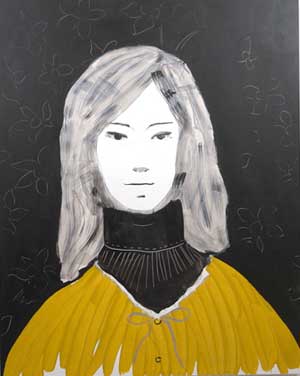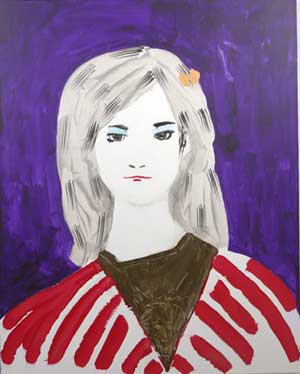In dreaming, faraway, Kerry Inman and Patrick Reynolds
showcase five emerging Japanese artists who favor a more pensive
approach to art making than their contemporaries, many of whom will be
featured throughout Houston this summer in such exhibitions as RED HOT
– Asian Art Today from the Chaney Family Collection at the Museum of
Fine Arts, Houston.
Yuko Murata sets the tone at Inman Gallery with four small paintings (all less than 20 x 25 inches) scattered over the gallery wall in a way that allows viewers to pass slowly from one contemplative composition to the next. In Harmony and Pond, Murata has isolated two barren trees within desolate landscapes—a muted mountain range in one, an icy lake in the other. These peaceful panoramas are juxtaposed with two slightly more cheerful paintings: Marble and Baby Horse. Marble contrasts a speckled horse with a soft blue backdrop, while Baby Horse plays a pale pink background off a yearling, whose front legs buckle as it steps tenuously onto an emerald green floor. Murata deliberately collapses the planes within each painting, calling forth the silent simplicity of children’s drawings.
Like Murata, Kyoko Murase refers to the classical Japanese landscape tradition, but her medium—a mixture of oil and colored pencil—heightens the work’s expressive quality. In Around the Lilac Rock #1 and Around the Lilac Rock #2, the artist has rendered a mythological scene using rough-hewn strokes of pastel pink, purple and teal, conferring the same naïve sensibility on her execution as she does on her narrative subject—a mysterious wood nymph embedded in the candy-colored landscape. Murase has depicted the androgynous figure again in two untitled drawings, but here the creature is set within a brooding sky or raging sea. Nestled safely in a tree, clinging to a bright red branch, Murase’s creature gently closes its eyes in the face of these tumultuous surroundings.
Shimon Minamikawa attacks his canvases in the same expressionistic manner as Murase. Arranged in a grid, Minamikawa’s four portraits address the relationship between a woman’s identity and her style of dress. In She (yukata), the artist highlights the subject’s teal yukata, a casual summer garment worn in Japan, by punctuating it with large red dots. Observing the woman’s clothing, one can make assumptions about her ethnicity and even her age (younger women in Japan tend to wear brighter yukatas). Minamikawa summons more potentially artificial markers in She (Harajuki) and She (Black turtle), the latter referring to the black turtleneck peeking out from beneath the figure’s modest mustard sweater. The former is titled after a shopping district in Japan that caters to young clients, selling clothes to the Japanese hipster and rockabilly alike. The girl in the image wears a loud red-and-white striped garment over a brown T-shirt, coupled with blue eye shadow, red lipstick and a small peach bow in her hair. Again, the dress aims to establish her character, an almost impossible task in this case, given the pervasive fusion of Eastern and Western fashion among teenagers worldwide.
All of the works in the exhibition rely heavily on the act of drawing, and Takehito Koganezawa’s playful compositions are no exception. Using a similarly vibrant palette of greens and pinks, the Berlin-based video artist and draftsman takes the line for a walk, as Paul Klee would say, only the sights—bunches of green onions combined with magenta eels and horses—make his two untitled drawings the most surreal of strolls. By contrast, Kanako Okazaki’s works resonate with quiet restraint. Her four self-portraits from the series My Beautiful Dream fuse drawing with photography, and portraiture with traditional Japanese motifs. In Decomposed, she has photographed herself in profile, lying down with a sheet over her head, then overlaid the negative with crumpled pieces of paper. Although indecipherable in this photograph, the identity of these scraps is revealed in Molded, which depicts the same figure, only uncovered, with the paper forms smoothed out to reveal doilies or paper snowflakes. Chrysanthemum and Chrysanthemum II feature the exact same photographs—one body covered and the other uncovered—only this time they are overlaid with line drawings of a white chrysanthemum, a symbol of the Japanese state. By fusing this imagery with the words “decomposed” and “molded,” terms associated metaphorically with character building (i.e., “to compose oneself” and “to be molded”), Okazaki alludes to the influence of nationality on one’s being, a force imposing or tracing itself on the body. Also associated with death, these words along with the chrysanthemum offer a moody commentary on the relationship between the self and the state.
Okazaki’s work, with its reserved palette and overwhelming sense of tranquility, underscores the overall difference between dreaming, faraway and other exhibitions of Asian art this summer. Although subtle humor and vigorous energy pervade their work, too, the artists in this exhibition differ from their contemporaries by opting for a deliberate return to innocence. Their simplified forms and narratives resemble private doodles more than anime figurines, providing an austere and understated complement to concurrent shows throughout Houston.
Images courtesy Inman Gallery
Margo Handwerker is a Curatorial Assistant of Prints & Drawings and Modern & Contemporary Art at the Museum of Fine Arts in Houston.










1 comment
Shimon Minamikawa was really cool, but Kyoko Murase’s paintings really suck.